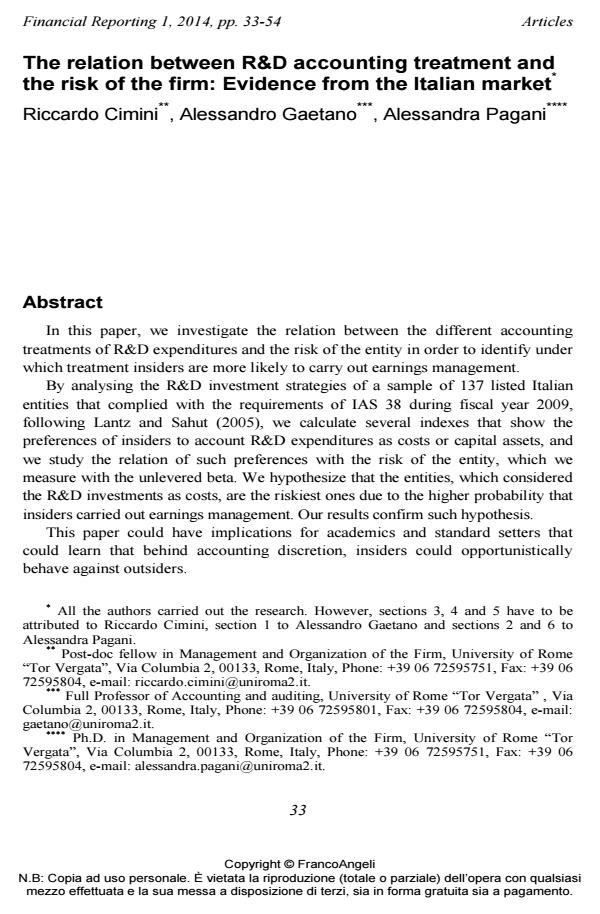The relation between R&D accounting treatment and the risk of the firm: Evidence from the Italian market
Titolo Rivista FINANCIAL REPORTING
Autori/Curatori Riccardo Cimini, Alessandro Gaetano, Alessandra Pagani
Anno di pubblicazione 2014 Fascicolo 2014/1
Lingua Inglese Numero pagine 22 P. 33-54 Dimensione file 286 KB
DOI 10.3280/FR2014-001002
Il DOI è il codice a barre della proprietà intellettuale: per saperne di più
clicca qui
Qui sotto puoi vedere in anteprima la prima pagina di questo articolo.
Se questo articolo ti interessa, lo puoi acquistare (e scaricare in formato pdf) seguendo le facili indicazioni per acquistare il download credit. Acquista Download Credits per scaricare questo Articolo in formato PDF

FrancoAngeli è membro della Publishers International Linking Association, Inc (PILA)associazione indipendente e non profit per facilitare (attraverso i servizi tecnologici implementati da CrossRef.org) l’accesso degli studiosi ai contenuti digitali nelle pubblicazioni professionali e scientifiche
In this paper, we investigate the relation between the different accounting treatments of R&D expenditures and the risk of the entity in order to identify under which treatment insiders are more likely to carry out earnings management. By analysing the R&D investment strategies of a sample of 137 listed Italian entities that complied with the requirements of IAS 38 during fiscal year 2009, following Lantz and Sahut (2005), we calculate several indexes that show the preferences of insiders to account R&D expenditures as costs or capital assets, and we study the relation of such preferences with the risk of the entity, which we measure with the unlevered beta. We hypothesize that the entities, which considered the R&D investments as costs, are the riskiest ones due to the higher probability that insiders carried out earnings management. Our results confirm such hypothesis. This paper could have implications for academics and standard setters that could learn that behind accounting discretion, insiders could opportunistically behave against outsiders.
Parole chiave:IAS 38; R&D accounting treatment; risk; earnings management. First submission: 30 June 2012, accepted: 31 March 2014
- Are tax incentives determinant and relevant for capitalizing R&D expenditures? Evidence from Europe Giuseppe Di Martino, Grazia Dicuonzo, Arcangelo Vitelli, Vittorio Dell’Atti, in FINANCIAL REPORTING 2/2020 pp.63
DOI: 10.3280/FR2020-002003 - The Relationship Between Enterprise Financial Risk and R&D Investment Under the Influence of the COVID-19 Xinfei Li, Baodong Cheng, Yueming Li, Jingyang Duan, Yuan Tian, in Frontiers in Public Health 910758/2022
DOI: 10.3389/fpubh.2022.910758
Riccardo Cimini, Alessandro Gaetano, Alessandra Pagani, The relation between R&D accounting treatment and the risk of the firm: Evidence from the Italian market in "FINANCIAL REPORTING" 1/2014, pp 33-54, DOI: 10.3280/FR2014-001002